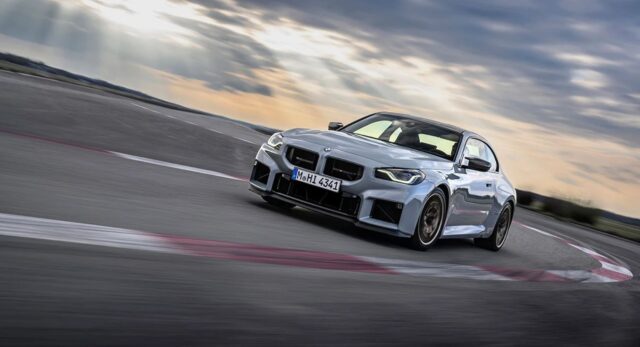
The automotive world is buzzing following BMW’s reveal of the new M2 CS, a high-performance variant that, despite shedding its manual transmission option, is experiencing overwhelming demand. This shift to an exclusive 8-speed automatic gearbox, driven by power handling requirements, highlights a changing landscape in performance car manufacturing and consumer preferences. BMW has already confirmed a surge in interest for the M2 CS, leading the company to increase production allocations to meet market expectations.
Key Takeaways:
- The 2026 BMW M2 CS is exclusively offered with an 8-speed M Steptronic automatic transmission, departing from the previous generation’s manual option.
- BMW states the existing 6-speed manual could not handle the M2 CS’s elevated torque output of 479 lb-ft (650 Nm) and 523 horsepower.
- Despite the absence of a manual, demand for the M2 CS is exceptionally strong, particularly in the United States, Germany, and China.
- BMW has increased build slots for the M2 CS to address the unexpected surge in customer orders.
- The M2 CS weighs approximately 97 pounds (44 kg) less than the standard M2 (Steptronic-equipped) and boasts a 0-60 mph time of 3.7 seconds.
- Pricing for the M2 CS starts around $98,600 (plus destination charges), making it a significant investment.
The decision to forgo a manual transmission in the latest BMW M2 CS has generated considerable discussion among enthusiasts. For years, the BMW M division has been synonymous with driver engagement, often celebrated for its precise manual gearboxes. However, the realities of modern performance, particularly managing higher torque outputs, have led BMW to a pragmatic choice: the existing 6-speed manual transmission, while cherished by purists, simply could not reliably handle the power produced by the M2 CS’s upgraded engine.
Frank van Meel, the head of BMW M, clarified that to exceed the 500 horsepower threshold and unlock the full torque of the S58 engine, an automatic transmission was necessary. The M2 CS’s 3.0-liter twin-turbo inline-six engine now produces a formidable 523 horsepower and 479 lb-ft of torque, a significant increase of 50 hp and 36 lb-ft over the standard M2 with the automatic gearbox. This power enables a 0-60 mph sprint in a claimed 3.7 seconds and a top speed of 188 mph with the M Driver’s Package.
While some purists express disappointment, the market response tells a different story. Reports from BMW indicate “huge demand” for the second-generation M2 CS. Sylvia Neubauer, Vice President of Customer, Brand, and Sales at BMW M, confirmed that production allocations have been increased “quite some units” to keep up with the strong interest. The United States leads the charge in demand, followed closely by Germany and China. This robust market reception underscores a broader trend: while a manual transmission holds symbolic value for some, outright performance, advanced technology, and exclusivity continue to drive consumer interest in high-end sports cars.
Engineering for Peak Performance: More Power, Less Weight
The BMW M2 CS is more than just a power upgrade; it embodies a holistic approach to enhancing track capability and driving dynamics. BMW M engineers have focused on reducing weight and refining chassis components to complement the increased engine output.
The M2 CS sheds approximately 97 pounds (44 kg) compared to the standard M2 equipped with the 8-speed automatic transmission. This weight reduction is achieved through the extensive use of lightweight materials. Carbon fiber reinforced plastic (CFRP) components are prominent, including the roof, trunk lid, M exterior mirror caps, and a CS-specific rear diffuser. The car also features a front splitter in matte black and a lightweight CFRP boot lid with an integrated ducktail spoiler, a distinctive design element that also contributes to aerodynamic stability at high speeds. Standard forged M light alloy wheels further contribute to weight savings and unsprung mass reduction.
Beyond weight, the M2 CS benefits from a series of chassis enhancements designed for sharper handling and greater control. It sits 0.2 inches (5.1 mm) lower than the standard M2, featuring new springs and adaptive dampers specifically tuned for the CS model. The M Servotronic steering system and the braking system have also received special calibration to manage the increased performance. M Carbon ceramic brakes are available as an option for those seeking the utmost in stopping power and fade resistance. The stability control and M Dynamic Mode systems have been revised, offering a more engaging and precise driving experience. The interior of the M2 CS features M Carbon bucket seats with an illuminated ‘CS’ logo, trimmed in Merino leather. Other refinements include a flat-bottom M Alcantara steering wheel and carbon fiber elements on the instrument cluster and center console.
The Manual Conundrum: A Question of Torque and Exclusivity
The absence of a manual gearbox in the M2 CS is a direct consequence of the engine’s increased torque. BMW’s engineers determined that the standard 6-speed manual, while available in the regular M2, could not reliably handle the 479 lb-ft (650 Nm) of torque produced by the S58 engine in the CS variant without significant over-engineering or compromising durability. This decision highlights a challenge faced by many automakers as power outputs continue to climb in performance vehicles.
While the 2020 M2 CS offered a manual option, that model’s torque output was lower, at 406 lb-ft (550 Nm). Furthermore, the limited-production BMW 3.0 CSL, which indeed features a 6-speed manual and over 500 horsepower, had its torque dialed down to 406 lb-ft (550 Nm) to accommodate the manual gearbox. BMW explained that the 3.0 CSL’s manual solution was “very specific” and not feasible for a higher-volume production car like the M2 CS, even with its limited run of under 2,000 units.
The M2 CS will be assembled at BMW Group Plant San Luis Potosí in Mexico, with market launch beginning in late summer 2025. With a starting price nearing six figures, the M2 CS positions itself as a premium offering in the compact high-performance sports car segment. Its strong market demand, despite the automatic-only configuration, points to a clear preference among buyers for outright performance and exclusivity, even if it means foregoing a traditional manual gearbox. This trend reflects a broader industry shift where automatic transmissions, particularly sophisticated units like BMW’s 8-speed M Steptronic, often provide faster lap times and superior acceleration compared to manual counterparts.
Market Dynamics and Future Outlook
The strong sales trajectory of the BMW M2 CS indicates a healthy appetite for focused, high-performance vehicles, even at a higher price point and with fewer traditional driver-engagement options. This success also comes at a crucial time for internal combustion engine (ICE) performance cars as the automotive industry moves towards electrification. The M2 CS might represent one of the final iterations of BMW’s entry-level M car to feature a pure combustion engine, making its exclusivity and performance even more appealing to collectors and enthusiasts.
For potential buyers, the M2 CS offers a distinct package. Its aggressive styling, including a slightly reworked grille and air vents, exclusive gold-finished forged wheels, and the prominent ducktail spoiler, sets it apart from the standard M2. Inside, beyond the M Carbon bucket seats, the car retains creature comforts such as a heated steering wheel, three-zone climate control, a head-up display, and a Harman Kardon sound system, blending track readiness with daily usability.
The M2 CS joins a lineage of special edition M cars that prioritize performance and exclusivity. Its immediate success in securing orders highlights that for a significant portion of the performance car market, the raw numbers—horsepower, torque, and acceleration—combined with a limited production run and M-specific enhancements, outweigh the desire for a manual transmission. This phenomenon signals a maturing market where cutting-edge technology and optimized performance are increasingly valued, even as the nostalgia for manual gearboxes persists in certain enthusiast circles. BMW’s strategy with the M2 CS appears to be a calculated success, satisfying the demand for a truly high-performing compact M car that pushes boundaries in terms of speed and dynamics.
Frequently Asked Questions (FAQs)
Q1: Why is the new BMW M2 CS only available with an automatic transmission?
A1: BMW engineers determined that the current 6-speed manual transmission could not reliably handle the increased torque output of 479 lb-ft (650 Nm) from the M2 CS’s upgraded 523-horsepower engine. To maximize performance and durability, an 8-speed M Steptronic automatic transmission was chosen as the sole gearbox.
Q2: How much power does the 2026 BMW M2 CS produce?
A2: The 2026 BMW M2 CS is powered by a 3.0-liter twin-turbo inline-six engine that generates 523 horsepower and 479 lb-ft (650 Nm) of torque.
Q3: Is the BMW M2 CS a limited production model?
A3: Yes, the BMW M2 CS will be produced in limited numbers. While exact global production figures are not fully disclosed, fewer than 2,000 units are expected to be built in a single model year, contributing to its exclusivity.
Q4: How does the M2 CS differ from the standard BMW M2?
A4: The M2 CS features a significant power increase (523 hp vs. 460 hp in the standard M2 automatic), weighs approximately 97 pounds (44 kg) less due to carbon fiber components, has a lower stance (0.2 inches), and boasts specific chassis tuning for its springs, dampers, steering, and brakes. It also has unique exterior styling elements and M Carbon bucket seats.
Q5: What is the 0-60 mph acceleration time for the BMW M2 CS?
A5: The 2026 BMW M2 CS can accelerate from 0 to 60 mph in a claimed 3.7 seconds.
Q6: What is the starting price of the BMW M2 CS?
A6: The starting MSRP for the 2026 BMW M2 CS is approximately $98,600, not including destination and handling charges.
Q7: Which markets are showing the highest demand for the M2 CS?
A7: The highest demand for the BMW M2 CS has been observed in the United States, followed by Germany and China.










